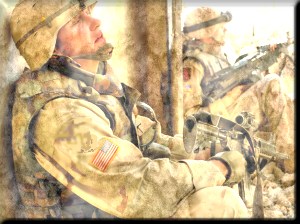
From Draft NOtices, April - June 2006Jarhead: Military Culture Under Fire— Michelle Gutiérrez |

|
|||
|
I recently viewed British director Sam Mendes’s 2005 film, Jarhead. Based on former Marine Anthony Swofford’s Gulf War memoir, the film depicts the experiences of United States soldiers. The film’s subject matter has a limited scope, but among post-Vietnam war movies (such as The Three Kings in 1999 and Black Hawk Down in 2001), Jarhead presents the most stinging critique of the effects of U.S. military culture on soldiers. By exposing the disillusionment of military life, soldiers’ lack of agency, and rampant homophobia and misogyny, Jarhead is the first film to lay bare the destructiveness of military culture since Stanley Kubrick’s Full Metal Jacket in 1987. However, the filmmakers’ stance on the Gulf War and many problematic aspects of military training are portrayed ambiguously. Mendes centers the film primarily on soldiers’ psychological wellbeing. The film begins and ends on this theme with a voiceover from Swofford stating, “A man fires a rifle for many years and he goes to war, and afterward he turns in the rifle to the armory and he believes he is finished with the rifle. But no matter what else he might do with his hands -- love a woman, build a house, change his son’s diaper -- his hands remember the rifle.” By encapsulating the film with this statement, Mendes communicates not only the long-lasting impact military training and war have on soldiers’ lives, but also the fact that soldiers are “regular” men who have jobs, wives, and children. Clearly, the constant harassment, teasing, and abuse by sergeants has a much more striking effect with this backdrop. It is vital for U.S. civilians to hear such messages since we can easily slip into the role of dispassionate spectators, but there are several aspects of this film that are problematic. First, the message that soldiers are men who love and have families like any other became entangled with more vexed messages about women’s roles. Mendes portrayed women as the primary contributors to soldiers' frustration by not writing letters and waiting patiently for their partners to return home. The image of disloyal women during this war is different from, for example, World War II, when the burden of maintaining soldiers’ morale was often placed on women, who were encouraged to write regularly and provide assurance that the domestic space was in order and secure. The popularity of pinups also encouraged men to feel that they were fighting for women back home. In Jarhead, rather than critiquing the gender roles that usually sustain militarism, the expression of soldiers’ disillusionment focused heavily on a break with previously established gender roles during war.
The film strongly encourages the audience to empathize with Swofford’s group of Marines, who are trained as sharpshooters for the war. However, the enormous variance in U.S. and Iraqi casualties is never made explicit. The film, for instance, never depicts a Marine shooting an Iraqi. This is arguably due to the reality that air strikes and “smart bombs” were responsible for the majority of casualties, but even the extent of death from air strikes was not made obvious in the film, and the audience is left with the feeling that not many people died. In reality, just over 300 U.S. soldiers were killed compared to at least 100,000 Iraqis. One thing the film did well is to depict the brutality and homophobia of the military. In the opening scene, Swofford’s drill sergeant accuses him of being homosexual, then humiliates him and orders him to do a push-up for every time his girlfriend cheats on him. In the following scene, the drill sergeant smacks the back of Swofford’s head repeatedly while commanding him to say what he’s doing in the military. When Swofford finally answers, he yells in anger, “Because I got lost on my way to college!” Then the sergeant grabs Swofford’s head and bangs it against a chalkboard. The film also demonstrates how soldiers adapt to and even embrace this brutal military culture after being immersed in it for awhile. In the beginning of the film, Swofford is told he would be attending bugle practice so he could be in the military band and is relieved to not have to participate in other types of military jobs. He also fakes being sick by drinking bottles of laxatives to avoid basic training. The transition of Swofford to a dispassionate soldier and a focused sharpshooter is clearly depicted. In one scene, a group of about 50 Marines watch the famous scene in Apocalypse Now in which soldiers shoot Vietnamese civilians from helicopters while playing Wagner. All the Marines, including Swofford, chant, jump from their seats, and cheer on the soldiers in the movie. Then they hear an announcement that they are being deployed to Iraq, which again makes the crowd erupt into cheers. This scene, which came directly out of Swofford’s memoir, was a sobering look at the way in which military culture is based not only on homophobia and misogyny but also brutal dehumanization. Although this film is quite limited and does not properly deal with homophobia, misogyny and gender roles, it does offer a view of military life that is generally shielded from plain view. Keeping in mind the film’s limitations, it can be a resource for creating productive dialogue about military life, culture, and war. This article is from Draft NOtices, the newsletter of the Committee Opposed to Militarism and the Draft (http://www.comdsd.org) |
||||